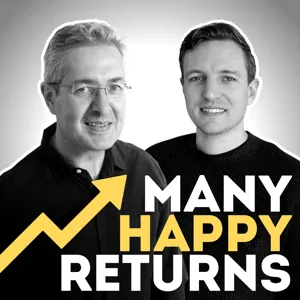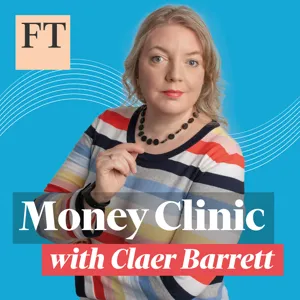Podcast Summary
Understanding Risks in Structured Products: Structured products can offer potential profits but also carry inherent risks. Proper hedging and a thorough understanding of underlying risks are crucial.
Structured products, like auto callables or equity-linked securities, offer investors an opportunity to make profits based on the performance of a specific index or currency. These products come with attractive names and can be complex, making it essential for investors to understand the risks involved. Historically, there have been instances of significant blow-ups with these structured products, such as the French bank Natixis's mishap in 2018 and the TARF incident in 2015. These incidents highlight the importance of proper hedging and a thorough understanding of the underlying risks. Essentially, investors should be aware that while structured products can offer potential profits, they also carry inherent risks that need to be carefully considered.
Structured Products: Attractive Investment Option for Risk-Averse Investors: Structured products, originating in Asia and Europe, offer risk-averse investors attractive investment features like currency hedging. However, as they've grown more complex, their risks have increased, potentially leading to delta hedging at banks and wider financial system impacts.
Structured products, which originated primarily in Asia and Europe, have been a popular investment option for retail investors and high net worth individuals in frontier markets where traditional equity and bond markets were not well-established. These products, often sold by banks, offered attractive investment characteristics, including currency hedging, and provided a way for investors to put their money in a relatively low-risk investment. A prototypical example would be a 50-year-old investor looking to make an investment but concerned about risk and volatility, who might be approached by a bank to buy a principal-protected note. This type of structured product guarantees the return of the initial investment at maturity, making it an attractive option for risk-averse investors. However, as the industry has evolved, structured products have become more complex, and the risks associated with them have grown. When these products encounter issues, it can lead to delta hedging at the issuing banks, which can impact the wider financial system and create a negative spiral.
Investors seek yield, structured products offer creative solutions: Reverse convertible auto calls let investors earn fixed income with limited downside risk, but assume significant losses if index has large negative return
In today's low-interest environment, investors are seeking decent yields, leading structured product manufacturers to think creatively and sell options to generate yield. One common type of product that has grown rapidly over the last decade is the reverse convertible auto call. In this arrangement, investors receive a fixed income stream in the form of a coupon, but they assume the risk of significant losses if the underlying index experiences a large negative return. Essentially, investors sell an option to the bank in exchange for the coupon. These products, often issued by French banks, offer investors upside potential in the equity market with limited downside risk, making them attractive to some investors. However, it's crucial for investors to understand the trade-offs and potential risks involved. In the past, these products were funded by buying 0 coupon bonds, but now, with low interest rates, banks find other ways to generate yield by selling options.
Selling Complex Financial Products: Multiple Fees and Hidden Risks: When buying complex financial products, investors face multiple fees and hidden risks, with only some of the costs being transparent. Banks generate fees by issuing liabilities and hedging market risk, using various desks and parties involved to receive commissions.
The sale of complex financial products by banks involves multiple layers of fees and commissions that are not always transparent to the end investor. When a retail investor buys a product like an auto callable or equity linked security, there are several parties involved, each of whom receives a fee or commission. The financial adviser or broker typically receives a commission, and there may also be an upfront load or effective commission for the bank. Within the bank, there are various desks involved in the creation and trading of the product, each of which may also receive a fee. The bank's goal is to generate fees while hedging its market risk. It achieves this by issuing a liability to the investor, promising to pay according to the terms of the note. For simpler products, such as principal protected notes, the bank can hedge its risk by buying zero coupon bonds and call options. However, for more complex products, such as reverse auto call securities, the bank may need to sell downside puts to hedge the risk. The complexity of these notes increases as implied volatility and yields fall, requiring the bank to add more features to maintain the desired yield for the client. One such feature is knock-in options, which can be tricky to hedge and do not have an easy replicating portfolio or option. Overall, the sale of complex financial products involves multiple fees and risks, with only some of the costs being transparent to the end investor.
Banks generate yield by selling put options for downside protection: Banks earn yield by selling put options, but face increasing risk as markets fall, requiring complex hedging strategies due to large, linked option portfolios in vast markets.
Banks manage complex risks in their portfolios by selling options to generate yield, specifically selling put options for downside protection. This involves receiving a premium from buyers, which can be considered a yield. However, the risk for the bank increases as the market falls until a certain point, at which the risk disappears. This is due to the binary nature of these options, where the outcome is either a significant loss for the investor if the market falls further, or the risk fading away if the market stays at the current level. The hedging of these risks is challenging due to the large and complex portfolios of these options with various linkages to different indices. Banks initially hedge with day 1 proxy hedges, but as these products age and indices fluctuate, the hedging becomes more complex. These markets are vast, with over $100,000,000,000 in issuance annually in countries like Korea and Japan.
European banks sell complex financial products to retail investors and hedge their risk with simpler put options: European banks generate revenue from complex financial products sold to retail investors and hedge their risk, but during market sell-offs, the downside protection bought can vanish, leaving banks short on options and requiring them to buy more puts and sell more futures to imperfectly hedge, potentially leading to significant losses.
European banks issue complex financial products to retail investors, buying downside protection in the process. These banks hedge their risk by selling simpler put options. However, during market sell-offs, the downside protection bought from retail investors can disappear quickly, leaving the banks short on options they've sold to hedge. This can lead to a shortfall, requiring banks to buy more puts and sell more futures to imperfectly hedge, all at the same time. Banks make most of their money from commissions and fees on these products but can also seek to generate profits through their hedges by taking on hidden risks. The 2015 Chinese market crash served as a prime example of this, with several banks suffering significant losses due to their hedge portfolios being heavily weighted towards variance swaps. This mismatch between the complex and simple hedges can lead to substantial risks for banks, especially during market volatility.
Variance swaps and auto call notes: Different purposes, unique risks: Both variance swaps and auto call notes offer unique benefits but also come with significant risks but banks must carefully manage these risks through hedging strategies and be prepared to adjust their positions as market conditions change.
Both variance swaps and portfolios of options serve different purposes in financial markets, but they come with unique risks. Variance swaps offer potential for higher returns in normal markets but expose the holder to significant losses during market downturns due to their squared exposure. On the other hand, auto call notes provide downside protection for investors until a certain index drop, but when that threshold is reached, the protection disappears, leaving the bank exposed to potential losses. Banks can hedge these products by selling put options, but as the market declines and the knockout point nears, the bank's short volatility position becomes increasingly risky. When the note knocks out, the bank must buy back the put options, leading to potential losses. This dynamic can cause banks to scramble to cover their hedges during market downturns, exacerbating volatility and potentially leading to significant losses. In summary, while both variance swaps and auto call notes offer unique benefits, they also come with significant risks that can lead to outsized losses during market downturns. Banks must carefully manage these risks through hedging strategies and be prepared to adjust their positions as market conditions change.
Impact of Financial Markets on Banks and Vice Versa: Regulators need to pay closer attention to potential risks in the relationship between financial markets and banks, especially when large institutions are involved. Investors can estimate volatility exposure and track market impact using publicly observable data.
The relationship between financial markets and banks can significantly impact each other, creating potential feedback loops. Regulators have historically taken a laissez-faire approach to this issue, focusing on investor protection and basic disclosures. However, as markets become more complex and interconnected, it's crucial for regulators to pay closer attention to potential risks, especially when large financial institutions are involved. For instance, in the case of Korean banks, their significant exposure to certain indices can make them major drivers of their own solvency. Determining potential risks in the options market, such as key levels for short squeezes, can be challenging due to the variety of underlying indices, issuance times, and daily repricings. However, with publicly observable issuance and modeling tools, investors can estimate the volatility exposure of banks' portfolios and track the impact of market movements on potential profits or losses. Overall, understanding the intricate relationship between financial markets and banks and staying informed about potential risks can help investors make informed decisions and mitigate potential losses. Regulators must also prioritize addressing these risks to ensure financial stability and protect investors.
Shift towards S&P 500 structured products: Banks benefit from retail investors selling long-term tail risk in major equity indices, allowing them to manage risk in larger, more liquid S&P 500 markets. Asset owners should consider their risk profile and potential cost of distress in equity exposure when seeking protection from options.
The trend in structured products has shifted towards those pegged to the US S&P 500 index due to lower implied volatilities and realized volatility in international markets, as well as the fact that US equity markets have experienced more volatility episodes in recent years. This shift benefits banks as manufacturers of these products by allowing them to manage risk more easily and in larger, more liquid markets. Retail investors are also a significant source of selling long-term tail risk in major equity indices. The key consideration for asset owners is understanding their risk profile and the potential cost of distress in their equity exposure, which can influence the type and amount of protection they seek from options. The banks' role is to effectively manage this risk by creating complex investment products for hedge funds, moving risk from smaller, less liquid markets into the S&P 500.
Banks use S&P 500 to hedge risk in global indices: Banks increasingly rely on S&P 500 options to hedge risk in various global indices due to their strong correlation.
The relationship between investment notes and indices, particularly the S&P 500, has grown more direct and significant in recent years. Banks issue notes linked to various indices, including the Eurostocks, Nikkei, and HSEI. However, when global equity markets decline, banks often find it most expedient to hedge their risk via S&P options due to the correlation between indices. Although a minority of notes are directly linked to the S&P, banks are increasingly using complex trades, like corridor variance spreads, to hedge their risk in both the index in question and the S&P. This shift has become increasingly important as the dynamics of other global markets, once considered secondary to US-centric investors, are now more closely tied to the S&P. This was evident during the market downturn in December 2020, where banks faced significant risk as their long volatility exposure began to disappear rapidly, only to be saved by a sudden market rally. Overall, the S&P has become a focal point for banks to manage their risk in response to global market movements.
Impact of Retail Players on Global Markets: Retail player activity in certain markets, like equity-linked notes in Korea and Japan, can create significant moves in index options and the underlying index during market declines, potentially impacting global financial markets.
The financial markets, particularly those involving structured products, have become increasingly interconnected and complex. This complexity can lead to self-reflexive dynamics, where attempts to hedge and balance portfolios create extreme scenarios. One such example is the market for equity-linked notes, which are heavily used in Korea and Japan. These notes are linked to the S&P 500 index, and the activity of retail players in these countries can create significant moves in S&P 500 options and the index itself during market declines. This can result in banks having to take various actions to manage their exposures. It's important for asset owners to be aware of these risks, as there will inevitably be a time when equity markets experience significant declines, potentially leading to a global recession. The size of this market and the way issuers have shifted their hedging to the S&P 500 creates a situation where the activity of retail players in these countries can create potentially extreme moves in the index. This self-reflexivity is not unique to equity-linked products but is also present in other markets, such as credit and volatility. It's a complex topic, but it's essential to understand the potential risks and how they can impact financial markets.
Equity-linked securities: Complexity and Risks for Retail Investors: Retail investors should consider the complexity and risks of equity-linked securities, potentially opting for simpler investment products or seeking professional advice.
The complexity of equity-linked securities raises questions about whether retail investors should be investing in them, given their limited understanding of the various payoff matrices, especially when they involve multiple indices. The creativeness and colorfulness of advertising for these securities might not accurately reflect their underlying risks. Retail investors, unless they are extremely sophisticated, may not be able to determine if they are getting a good value. It might be more suitable for them to stick to simpler investment products or seek professional advice. The discussion also touched upon the potential for retail investors to create their own bespoke risk setups, but that might require a level of expertise beyond the average investor. The hosts encouraged following Ben Eifert, their guest, on Twitter, as well as other Bloomberg podcasts and personalities mentioned in the episode.





